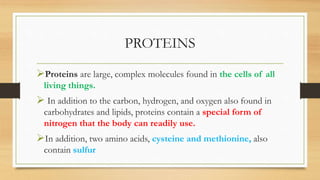
PROTEINS.pptx
- 1. PROTEINS Proteins are large, complex molecules found in the cells of all living things. In addition to the carbon, hydrogen, and oxygen also found in carbohydrates and lipids, proteins contain a special form of nitrogen that the body can readily use. In addition, two amino acids, cysteine and methionine, also contain sulfur
- 2. Proteins • The proteins in our bodies are made from a combination of building blocks called amino acids, molecules composed of a 1. Central carbon atom connected to four other groups: 2. Amine group (NH2) 3. An acid group (COOH) 4. A hydrogen atom 5. A side chain
- 3. STRUCTURE OF AMINO-ACID COOH H C-----R( group) NH2 NB: Variations in the structure of the R group give each amino acid its distinct properties.
- 4. Types of amino acids. They are subdivided into two categories: i. Essential (indispensable) amino acids ii. Non-essential (dispensable) amino acids.
- 5. 1. Essential amino acids Amino acids not produced by the body or not produced in sufficient amounts so that they must be obtained from food. They are 9 in number. NB; CHECK EXAPLES FROM THE NOTES
- 6. 2. Non-essential amino acids Amino acids that can be manufactured by the body in sufficient quantities and therefore do not need to be consumed regularly in our diet. They are 11 in number NB; CHECK EXAPLES FROM THE NOTES
- 7. Types of proteins 1. Complete proteins Foods that contain all nine essential amino acids. 2. Incomplete proteins Foods that do not contain all of the essential amino acids in sufficient amounts to support growth and health.
- 8. Types of proteins 3. Complementary proteins Proteins contained in two or more foods that together contain all nine essential amino acids necessary for a complete protein. It is not necessary to eat complementary proteins at the same meal.
- 9. Proteins Mutual supplementation The process of combining two or more incomplete protein sources to make a complete protein.
- 10. PROTEIN QUALITY Protein quality is affected by ; i. Amino acid content ii. Digestibility
- 11. I. Amino acid content The quantity of essential amino acids in a protein determines its quality: 1. Higher-protein quality foods Are those that contain more of the essential amino acids in sufficient quantities needed to build proteins. 2. Lower-protein-quality foods Contain fewer essential amino acids.
- 12. II. Digestibility Digestibility, or how well the body can digest a protein. The Protein Digestibility Corrected Amino Acid Score (PDCAAS) uses the chemical score and a correction factor for digestibility to calculate a value for protein quality.
- 13. II. Digestibility Proteins with higher digestibility are more complete. Animal protein sources such as meat and dairy products are highly digestible, as are many soy products; we can absorb more than 90% of these proteins.
- 14. II. Digestibility Legumes are also highly digestible (about 70% to 80%). Grains and many vegetable proteins are less digestible, with PDCAAS values ranging from 60% to 90%.
- 15. PROTEIN QUALITY These measures of protein quality are useful when determining the quality of protein available to populations of people.
- 16. Roles of proteins i. Proteins Contribute to Cell Growth, Repair and Maintenance ii. Proteins Act as Enzymes and Hormones- examples include insulin, a hormone that acts on cell membranes to facilitate the transport of glucose into cells; glucagon, which responds to conditions of low blood glucose, and thyroid hormone, which helps control our resting metabolic rate.
- 17. Roles of proteins iii. Proteins Help Maintain Fluid and Electrolyte Balance iv. Proteins Help Maintain Acid–Base Balance
- 19. Roles of proteins • Proteins Serve as an Energy Source • Proteins Assist in the Transport and Storage of Nutrients- lipoproteins contain (lipids bound to proteins) which allows the transport of hydrophobic lipids through the watery medium of blood.
- 20. Another example of a transport protein is transferrin, which carries iron in the blood. Ferritin, in contrast, is an example of a storage protein which is the compound in which iron is stored in the liver.
- 21. Roles of proteins Proteins Help Maintain a Strong Immune System e.g. antibodies. Their production is prompted by the presence of bacteria, viruses, toxins, and allergens.
- 22. Disorders associated with proteins High protein intake may increase the risk of health problems. Three health conditions that have received particular attention include 1. Heart disease 2. Bone loss 3. Kidney disease.
- 23. Disorders associated with proteins High-protein diets composed of predominantly animal sources are associated with higher blood cholesterol levels. This is probably due to the saturated fat in animal products, which is known to increase blood cholesterol levels and the risk of heart disease.
- 24. Disorders associated with proteins • High Protein Intake May Contribute to Bone Loss because they increase calcium excretion. This may be because animal products contain more of the sulfur amino acids (methionine and cysteine). Metabolizing these amino acids makes the blood more acidic, and calcium is pulled from the bone to buffer these acids.
- 25. Disorders associated with proteins 3. High Protein Intake Can Increase the Risk for Kidney Disease